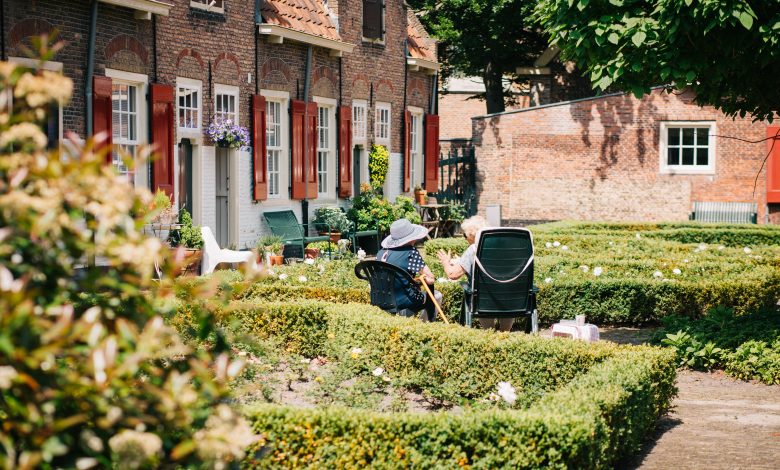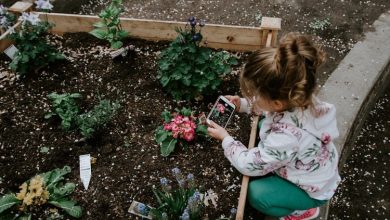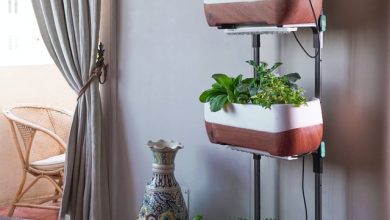How to Design a Senior-Friendly Garden

There is no right or wrong way to garden; rather, gardening is a hobby or occupation that includes growing and maintaining a garden space. It might be created for display, harvesting, or simply enjoyment. Without much of a rule book to go by, people can create spaces that reflect their personal preferences and often end up producing a space that’s very unique and comforting in the process.
The design of a garden is formed based on the usage of the garden and who will be using it, as this will provide more information about what kind of plants, lighting, and structures work best. If you are designing a garden space for a senior, you’ll want to take quite a few aspects into consideration for the design.
Seniors have varying abilities and disabilities, and gardens must be designed with these in mind. If you want to know how to design a senior-friendly garden, consider the helpful information below to help you get started.
Getting Seniors Outdoors
Every individual in their senior years is experiencing life differently. While some people will struggle with fine motor skills, another may have trouble hearing. Similarly, some seniors will have aged without a single health issue yet! In any case, each person considered to be a “senior” still needs to be stimulated to promote healthy aging. One of the ways to do this is to provide seniors with lots of time in the great outdoors.
It has been proven that being outside is good for us – all of us. Regardless of your age or abilities, humans respond very well to spending time outdoors. Being outside helps to stimulate the brain, increases motor skills, reduces stress, and makes us feel more positive. This is why it is no surprise that elderly people need to have their time outside; it helps them to stay active, and to maintain social relationships. Any senior who spends all of their time indoors is missing out on a lot of beneficial experiences.
Mental and Emotional Benefits
The mental and emotional health of seniors is just as important as their physical well-being. Being able to enjoy a garden, or better yet, help with the gardening, can largely reduce the amount of anxiety and stress a senior is feeling. It is also a grounding activity, so to speak, which calms a senior’s nerves and sometimes makes them feel more relaxed when they’re in a new environment.
Additionally, having the ability to help nourish and take care of something in a garden provides seniors with a feeling of renewed purpose. This is especially important if the senior rarely has visitors or if they do not have family and friends around anymore.
Incorporating a senior’s garden that can be harvested is also ideal since they can see the fruits of their labor after all of their hard work. It can be extremely rewarding for seniors to grow their own foods or flowers and to see them in a vase or in a meal they make later.
Physical Benefits
As we age, it is not uncommon for us to experience common aches and pains. We’re less flexible than we used to be, and not as strong, either. However, seniors should always be moving and staying active to maintain good health. With regular exercise, seniors can increase their ability to fight off lots of severe illnesses, including diabetes, osteoporosis, cardiovascular disease, and other conditions related to aging. Some diseases are impossible to prevent but can be slowed and controlled with physical activity.
Social Benefits
It’s important to remember that many seniors no longer have their friends, family, and spouses around for comfort. Some seniors spend their last days all alone, without anyone to spur their social skills and keep them optimistic about each day. Fortunately, a senior’s garden is a great way to maintain the social skills that often come with it. Gardeners can teach each other new tricks, share their own memories, and look forward to something together.
All of this being said, it’s no surprise that having a garden to explore and enjoy is ideal for the senior population. Whether it’s a personal garden or a shared one, a well-designed garden is one that they can easily travel through and enjoy.
So, what does that entail?

Safety in Your Garden Design
One of the most important components of a garden designed for seniors is that it is safe. This is especially true if you are creating a garden that is going to be used by people with severe and mild disabilities.
The best garden design for seniors should be one that makes them feel safe and supported when they’re enjoying it. This shouldn’t be a space that poses all kinds of dangers or one that doesn’t serve their personal needs. With that in mind, there are some important components to remember:
Shade
The shade is so important for the safety of seniors. As we age, our skin begins to become more susceptible to the sun, and burns can occur more easily. Not to mention, elderly individuals have an increased risk of heatstroke when they’re in the sun for too long.
This shouldn’t be too hard of a component to remember since almost everyone who enjoys outdoor spaces on a hot day will seek shade at one point or another.
A simple way to incorporate shade into a senior’s garden is to have furniture that has a built-in umbrella. This is a more affordable option that will still let you choose a specific color or design you want to feature.
More expensive options include gazebos, retractable canopies, or shade sails. These options are built into a structure in the garden, like a house or fence. They take more time but can be larger and cover more area than an umbrella.
Of course, you can always consider adding natural elements that provide shade, such as large bushes and trees. Trees will take longer to grow to their full height, or you might transport an adult tree for immediate shade. Choose something that doesn’t require a lot of maintenance and which has lots of shade, including tulip trees, dogwood, maples, weeping willows, and oaks.
Seating
Of course, no seniors’ garden is complete without proper seating. Most elderly people will tire after a bit of activity, so they’ll need spaces to relax after exploring the garden space.
Additionally, a seating area makes the garden a welcome space where seniors can spend more of their time and enjoy the outdoors. You’ll want to take the design of your seating into consideration and go for comfort over style. Seating that is padded and ergonomic is best, so it will be easy to get into and easy to get up from. Your senior garden design should have some seating in the sunshine and some in the shade. This way, you can cater to the specific preferences of each person.
Raised Garden Beds
A senior garden design should consider what kinds of things people will want to do within the garden. Sitting and walking are obvious, but how many people will want to actually take part in the planting and maintaining process?
For able-bodied seniors, giving them activities to help with is a great way to maintain their fine motor skills. That being said, we all know how much gardening can take a toll on our bodies, and you wouldn’t want to put seniors in danger while they garden.
Raised garden beds are the latest and greatest in garden trends. The raised beds allow for gardeners to enjoy weed and pest-free plants, while also avoiding sore backs, knees, and other issues while tending to their gardens. A raised garden bed is perfect for seniors so that they can plant and tend to growth without bending, kneeling, or lifting heavy objects from the ground. They can take part in the gardening process at waist-height, ensuring that they keep their limbs moving and their minds engaged.
Senior-Safe Tools
These days, you can get all kinds of garden tools in various shapes and sizes with unique details to make things easier. Fortunately, these upgrades are doing wonders for seniors who often require extra support and ergonomic designs in their tools.
Tools like garden forks, weed-pullers, shovels, and spades all come in different designs that have added padding on handles and smarter shapes to make gardening a breeze. It’s important that, if you have seniors helping with gardening activities, they have access to these items.
Without ergonomic garden tools, seniors can experience sore backs, blisters, slivers, and more. Tools should also be lightweight and easy to hold to make gardening easier and more enjoyable.
Accessibility in Your Garden Design
Once you’ve covered the safety issues in your garden, you’ll then want to make sure that it’s accessible for everyone. That means creating a layout that makes it easy to get from one point of the garden to the next.
If any point of your garden lacks accessibility, seniors will likely never get to experience those areas of the space. Here are some tips to improve accessibility in your garden:
Wide Pathways
Some of the people enjoying a seniors’ garden will need lots of space to get around. Perhaps they are moving with a cane or even a wheelchair. A garden that has pathways that are too narrow will inhibit the use of the garden, at least for those who are unable to walk on their own.
Sidewalks should be wide in every row, and they should be easy to navigate. This also means having wide turns, gently sloping-ramps, and handles where necessary. Naturally, if there are any stairways in the space, a ramp is a must for disabled individuals.
Smooth Surfaces
Even if you have wide, accessible pathways in your garden design, they won’t be usable if they are not smooth. Paths that have holes, edges, and uneven surfaces can be cause for tripping and injury, which is the last thing you want.
When creating the garden’s pathways, make sure to consider materials that will resist raising, dipping, and slipping. If the weather has been rainy, you’ll also want to avoid any surface that could cause pooling. During garden landscaping, take care that paths have a gentle slope so that water runs away from the area.
Granite and gravel have great potential for pathways, specifically because they will stay compact and won’t become slippery in rain. Keep in mind, though, that they will be harder to shovel in the winter.
Bricks and pavers laid down by professionals are another great choice, since they will resist movement and will last a long time. Tire-derived materials are an ideal choice if you’re going for a long-lasting, eco-friendly approach. These surfaces are very resilient, and they stop car tires from spending an eternity in the landfill. Additionally, these paths will bend to maneuver with tree roots instead of break, and you can order them in a plethora of colors to match your garden design color scheme.
Unique Garden Designs
If you know that you’re catering to people who will be in wheelchairs, use this knowledge to create garden beds that are accessible. Not only should they sit at a certain height, but you might also manipulate the shape of the garden so that people can sit at the center of a garden bed, instead of having to sit alongside a wall. This way, the gardener has garden space in every direction around them, and the height makes it easy for them to access everything.

Things to Consider for a Senior Garden Design
Knowing who is going to be using a garden will help you to make design choices that cater to their needs. With a senior garden, it’s best to assume that you’ll have a plethora of different ailments or disabilities that will need to be considered. These include:
Vision Impairment
Some of the seniors who walk through your garden design will have trouble seeing. With that in mind, your garden design needs to be organized and free of clutter to avoid mishaps.
Try to keep your pathways clear of debris, and make sure that the edges of the pathways aren’t too sharp. If you have raised garden beds lining your garden, you might consider rubber pads for their corners.
Additionally, implementing bright colors is a great way to help seniors with eye vision see things more clearly. An array of florals in different sizes and colors might help them to distinguish various plants and how vivid they are. If you have anyone dealing with color-blindness, consider adding plants in the colors that they can recognize.
Heat Exposure
Your garden will need to be able to cater to seniors regardless of where they are in the garden. If it is a large space, there should be multiple rest points and lots of shade throughout.
Similarly, it doesn’t hurt to have water stations located around the garden, or at least some kind of water feature. If seniors feel faint or too warm, a great garden design will have a solution for them nearby.
Easy Maintenance
Whether the seniors using your garden design are helping with the gardening or not, it is beneficial to have plants and features that are very low-maintenance.
This way, you can be sure that the garden won’t experience excessive weeds, creeping vines that can be tripped on, or structures that fall over in bad weather.
You might also consider plants that don’t require trimming and which won’t attract insects like bees and pests.
A designated seniors’ garden might be a great idea, which can be grown in a raised bed and includes plants or food that are easy to care for. This way, other needier plants in the garden can be looked after by professionals, while the seniors can still take part in the gardening process in a simpler way.
Elements to Consider in a Senior-Friendly Garden
Aside from furniture, shade, and plants, there are lots of other components you can incorporate into a senior-friendly garden. These sorts of components will encourage seniors to inspect their space, socialize with others, and enjoy personal time.
Wildlife Element
It can be very soothing and entertaining to watch wildlife in the outdoors. That being said, implementing a wildlife structure in a senior-friendly garden is a great idea.
There are quite a few things you can incorporate into the space:
- Bird feeders
- Bird baths
- Fish ponds
- Bee apartment
- Butterfly gardens
All of these elements will entice different creatures to come and visit the garden, so long as they are placed far enough away from the people who are viewing them.
Seniors might even be enticed to write about the animals they are seeing or to start social groups that discuss what kinds of things they can do to help the wildlife in their space. Bringing wildlife into a garden is always a great benefit.
Quiet Space Element
There’s nothing quite like having your own personal secret garden to escape away to after a hard day. Some quiet spaces are ideal for senior garden design so that, when individuals need their personal quiet time, they can enjoy it outdoors.
These spaces are simple enough to create; you can create privacy with some tall bushes or vines, and you can place them away from busy areas where it will be quiet and peaceful.
Here you’ll want to incorporate something like a reading nook or perhaps an outdoor table where they can do a puzzle. Gardens are great for socializing, but if someone wants a small area for personal reflection, this should be accessible as well.

Great Flowers for Senior Gardens
The following are some plants and flowers that are easily maintained and ideal for senior care:
- Magnolias: This is a flowering plant that is very beautiful when it blooms. They’re easy enough to care for, and they don’t seem to be as susceptible to disease and pests as other plants. This is important, since seniors may struggle with the sprays used to try and get rid of these problems.
- Citrus Trees: If you’re living in a warm climate, citrus trees are always a fan favorite of low-maintenance gardens. These trees require pretty basic needs, including consistent watering, mulching, and fertilizing. It can be incredibly rewarding for seniors to care for a plant and then be able to enjoy the fruits that they’ve helped to grow.
- Sedums: Sedums are succulents, which means they rarely require any watering. Mostly they will require six to eight hours of sunshine, and rarely will they grow out of control. Sedums come in many varieties and often have bright, vibrant pink and purple colors. They’re easy to trim back if necessary and are ideal for attracting butterflies and bees. Seniors will have no trouble taking care of these plants, especially since watering and fertilizing are rarely necessary.
The Perfect Garden Design
In creating a senior-friendly garden, it’s important that you focus on the needs of the visitors, and less on what plants and styles are “in” right now. Of course, you’ll want this garden to be aesthetically pleasing, but the main goal is to allow seniors to enjoy the space without experiencing discomfort or harm. Building a safe space that can be easily maintained is the main goal, and the rest will follow.
Over time, you will notice where you can improve the space or what changes need to be made to suit the preferences of the garden’s visitors. So long as it is safe, you’ll be able to manipulate other aspects of the garden to make it more fun or more user-friendly.
Regardless of the work it involves, this kind of project is always worth the effort.



